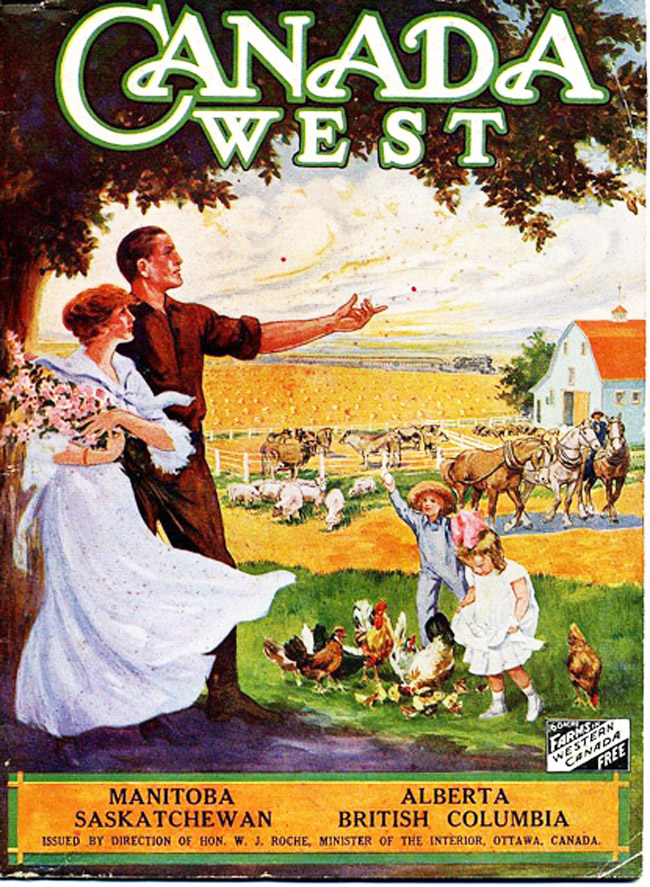Homesteaders were hoodwinked by an unscrupulous Canadian government that lied about the life awaiting them in the so-called land of promise, resulting in untold hardship and heartbreak.

Welcome to Letters From Windermere, a monthly blog in which I write about:
- HISTORY: mostly Western Canada history, plus anything else that interests me;
- WRITING: behind-the-scenes info about my next work of historical fiction;
- BOOKS: I recommend a good book every month.
* * * *
PITY THE HOMESTEADERS
It seems incredible in these days of global information that so little was known overseas about Western Canada in the early days.
The only source of knowledge at that time was propaganda from the Government of Canada, in the form of printed posters and brochures; and lectures by government agents trying to lure people to leave everything behind in exchange for free land.
To recap: in 1870 the newly-formed Government of Canada purchased Rupertsland, which had previously been controlled by the Hudson Bay Company. This was a vast area amounting to one-third of what is now Canada, including northern Ontario, northern Quebec, the prairie provinces, and the Northwest Territories.
The new government wanted to encourage white settlement, so (after moving the Indigenous peoples onto reserves and evicting the Métis from their homeland in Manitoba), it mounted a massive advertising campaign in Britain and Europe.
The Dominion Lands Act (similar to the Homestead Act in the United States) was passed in 1872 and lasted until 1930. In return for 160 acres of land, the claimant had to “prove up” by meeting some draconian conditions: build a habitable dwelling, live on the property for three years, and cultivate thirty acres. (See some photos of these early dwellings here: Homesteaders Built Shacks.)
How were these hapless homesteaders to learn the truth about what they were getting themselves into? There were no photographs, they didn’t know anyone who had been to North America and returned, and the newspapers were either ignorant or complicit in the deception.
Instead, they saw posters like this, showing livestock, vegetables, and golden grain.

Since women had to be convinced to leave their homes in the Old Country, many posters targeted them. In some ways women had the most to lose, in terms of home and family, but they also were keen to provide a better future for their children.
This illustration, showing a prosperous farmstead and a rosy-cheeked infant, must have looked like paradise if you were eking out a living as a tenant on some lord’s estate, or scrubbing floors in a London hotel.

Honestly, the scammers of today have nothing on these early con artists!
Take a look at this poster calling Western Canada THE NEW ELDORADO (referring to a gold mine) and telling people they have NOTHING TO FEAR.

Mr. J. Bruce Walker, whoever he was, no doubt thrilled spectators with his descriptions of an earthly paradise during this lecture in Glasgow, Scotland on January 16, 1905. Note “Healthy Climate!” was misleading at best, and “Free Schools!” that had not yet been built.

And you can bet your bottom dollar that Mr. Walker spoke no word about the Indigenous peoples of Canada! If there were any questions from the audience, they were no doubt told that the original inhabitants had peacefully agreed to move onto beautiful tracts of land where they could hunt and fish to their heart’s content.
Other nationalities were targeted as well. This poster was issued in Swedish.

This one in French may have been distributed in France or Quebec, which was pretty settled by the time Western Canada opened up. Many of the homesteaders came from Ontario, Quebec, and the United States.

This new government also cut a deal with the Canadian Pacific Railway. In exchange for building a transcontinental railway, the CPR was granted huge tracts of land which it sold to unsuspecting settlers who had the cash, and didn’t want the hard work of proving up. The CPR advertised ready-made farms which consisted of a shack (sometimes still under construction) and not much else.
So the immigrants were hoodwinked on every side, since most of the railway agents were operating on commission, and just as untruthful as the government agents.

As a result, more than ONE MILLION people left their homelands and moved to Canada in search of a better life.
They found a reality that was much, much different.
It was back-breaking labour to clear the land and till the soil, and farmers (then, as now) were plagued with crop diseases, insects, frosts, hailstorms, and drought. This photograph shows a prairie dust storm.

NONE of those propaganda posters showed the landscape in winter!
With inadequate shelter and clothing, and often a lack of firewood and food, many homesteaders abandoned their claims during that first terrible winter. Some of them, the number isn’t known, simply did not survive. (For obvious reasons, it was hard to find a photo of a homestead in winter. The photo below is a rare shot taken in North Dakota.)
Only three out of five homesteaders hung in there long enough to successfully claim title to their land.

Even the community where I live now, Invermere, British Columbia, was settled by British people who were told that the valley was perfect for fruit orchards. These were not homesteaders, and they paid hard cash for their mostly worthless property.
The Columbia Valley Irrigated Fruit Lands Company was created by Robert Randolph Bruce, who later became the Governor-General of British Columbia.
The futile efforts of newcomers who failed dismally to grow apples in this semi-arid region were described in this collection of letters home, written by Daisy Phillips, and published by the University of British Columbia Press.
Daisy accompanied her husband Captain Jack Phillips from England to Canada in 1912, their dreams based on nothing more than a brochure he picked up in a train station.
Although her experience was not a happy one, it is from her wonderful book that I borrowed the name for my blog!

Today millions of Canadians are descended from those original homesteaders, including my own great-grandparents Peter Florence and Annie McRobbie, who came from Aberdeenshire, Scotland with their infant daughter and homesteaded at Balmoral, Manitoba in 1875.
They and others like them were the inspiration for my new novel about a Scottish woman who finds herself homesteading on the Canadian prairie.
More details will be announced in the coming months!
* * * * *
MY WRITING JOURNEY
My writing journey began long ago and has taken me in many directions.
I was originally inspired by the Emily of New Moon books. Emily Byrd Starr was a fictional character who wanted to be a writer, featured in a trilogy by Lucy Maud Montgomery (who also wrote the Anne of Green Gables series).

Based on her example, I wrote my first story at the age of twelve years, and sent it to the Family Herald (a popular farming magazine published by the Montreal Gazette from 1869 to 1968).
I still have their very encouraging reply, the first of many rejection letters. I didn’t keep the original story, but I do recall it was called “Avril’s Rainbow.”
If you can’t read this note, it says: “Nicely prepared but the theme is rather too similar to a lot of other fairy stories. Keep trying!” And I did.

My very first published words were printed in a newspaper without my knowledge!
After graduating from the University of Saskatchewan in 1971, I worked at the Strathcona branch of the Edmonton Public Library for a year, and then spent six months travelling throughout Europe with a girlfriend.
Every week I dutifully wrote home to my parents. Little did I know that my mother was submitting my letters (along with a photo of myself, which I hated) to the local North Battleford News-Optimist! You can imagine the scene that ensued when I arrived home and found out!
And being my proud mother, she naturally kept all the clippings in her scrapbook. This is one of them.

My friend and I travelled through Europe with the guidebook, Europe on Five Dollars a Day, by Arthur Frommer. And we did actually survive on five dollars a day, thanks to hitch-hiking and youth hostels.
It’s a far cry from my upcoming journey to England at the end of April, when I will sail from Southampton, England to New York City on the Queen Mary 2! I’ll join thirty other writers on a voyage devoted to learning more about our craft.

I even have a photo of my actual cabin, No. 4027.

I’ll be writing and posting photos about this trip in my May blog, so don’t forget to susbscribe to this blog if you haven’t already done so. Just enter your email address here: Subscribe to Letters From Windermere.
And please share this with a friend who might be interested.
* * * * *
BOOK OF THE MONTH
There is nothing better than a novel filled with interesting facts (like my own historical fiction); or a true story that is so exciting it reads like a work of fiction.
Grass Beyond the Mountains is a memoir by Rich Hobson, a natural storyteller who came up from Wyoming with his buddy Pan Phillips in 1934 and started a huge cattle ranch in the interior of British Columbia.

According to Rich: “It took me thirteen years of punching cows and breaking horses, several cracked bones, my feet frozen twice, and a marriage, before I finally achieved a ranch of my own.”
This book has everything from blizzards to grizzly bears. Even better, this is the first of a trilogy and the books that continue the adventures of these two intrepid cowboys are: Nothing Too Good for a Cowboy, and The Rancher Takes a Wife.
* * * * *
Friends, this will be an exciting year as I have so much to share with you. I can’t wait to tell you about my trip on the Queen Mary 2, and my month-long stay in June at the Wallace Stegner House in Eastend, Saskatchewan. And of course, all the latest news about my new novel!
Do you have homesteaders in your own heritage? If so, please comment below.
Warmly, Elinor
Thank you for reading this post. Don't forget to subscribe!
